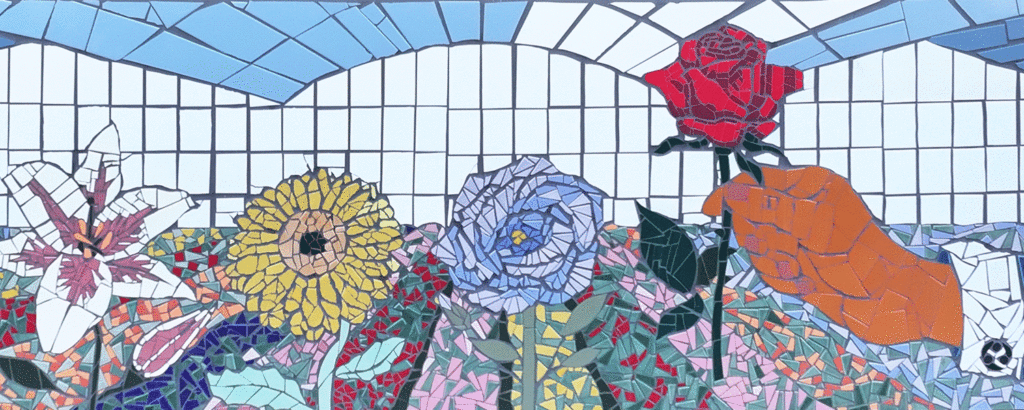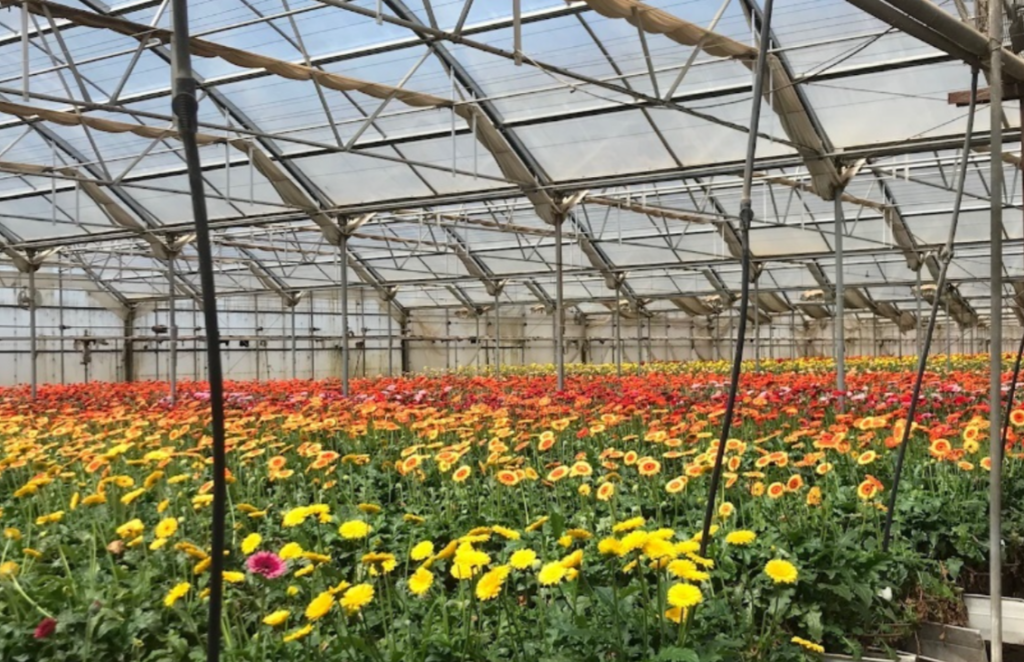Señor Kee and Me


THE STORY OF THE KITAYAMA FAMILY IN WATSONVILLE
It was decided that the project name should honor Kee Kitayama, who came to Watsonville with his family, set up the farm, and built the greenhouses. “Señor Kee Aqui” was suggested because Watsonville was the new home for the Kee, Keiko, and family. This then evolved into “Señor Kee and Me” as a way to include all the extended Kitayama family members who contributed, helped design, and assemble the mosaic.
About the design:
The “Señor Kee and Me” mosaic design was a collaboration of 3 family artists: Jennifer Uhlig, Eileen Kitayama, and Mike Rosenstein. Each submitted their art for consideration, and in the end, the judges found each had strong and meaningful images. So, with the help of Heidi Alonzo, who blended the three artists images together, we end up with our collaborative final design. The artist’s thoughts are below:
JENNIFER UHLIG, granddaughter of Tom Kitayama:
Every year when I help at the Gerbera Festival, I make sure I take a break to tour the greenhouses. Though always the same, I was always amazed and felt engulfed in color from all the Gerbera daisies. It is like stepping onto a rainbow, with warm air surrounding you, the gentle hum of the air circulators, and an endless sea of flowers smiling up at the glass windows above, like a cathedral of beauty and brightness. I imagine that most people touring the greenhouses experience this as they enter for the first time or the fiftieth time.

EILEEN KITAYAMA, granddaughter of Ray Kitayama:
Our family’s mosaic panel shows the inside of a greenhouse with rows of colorful flowers in the background and six different flowers in the foreground: snapdragon, carnation, lily, gerbera daisy, lisianthus, and rose. These were some of the main varieties of cut flowers that the family business grew. Symbolically, the six unique flowers are also meant to represent the individuality, beauty, and resilience of the six siblings in the generation that founded the family business: Tom, Ray, Yoshiko, Kee, Ted, and Martha.
If you look closely, you will see that the design also includes the Kitayama mon (Japanese family crest). This particular mon is called the mitsudomoe, which resembles three black comma shapes arranged on a white background with their outer edges forming a circle. While the meaning of the mitsudomoe varies from person to person, one interpretation is that it represents the cycle of life, and a constant moving forward of energy and regrowth. It is also a symbol of strength and courage. These themes ring true in the story of the Kitayama family.
By 1990, Kitayama Brothers grew to be the largest cut flower grower in the nation, but more importantly, it was a business that supported the livelihoods of the family shareholders, family employees, and dedicated non-family employees. Part of KB’s lasting legacy is that the business brought our large extended family closer together. There was always lots of people, noise, laughter, food, and fresh flowers at each family gathering. And for over a decade, KB Watsonville hosted the “Annual Open House / Gerbera Festival” that raised funds and benefitted “Friends of Santa Cruz State Parks”.
While 2024 sadly marked the end of Kitayama Brothers growing flowers, the Kitayama family’s love of flowers, family, and the local community continues. Our Mural “Señor Kee and Me” is a permanent part of the “Watsonville Brillante” community art project and is a monument to Kee, Keiko, and all other family members who have passed away. And it is a celebration of the Kitayama family’s history, traditions, and values.
MIKE ROSENSTEIN, son-in-law of Kee Kitayama:
“I chose to illustrate Kee’s connection to the community and the flower industry through the gentle grip of his hand on the heart of the family business—the rose. The positioning of the hand conveys an offering to an unseen recipient representing the community. And I wanted to include the Kitayama crest on the cufflink to show the importance of family.”
KEE KITAYAMA AND KB WATSONVILLE STORY
Kee and Keiko Kitayama moved to Watsonville in 1970, looking to expand the Kitayama family flower business to the Watsonville area. The greenhouses and facilities Kee built made KB Watsonville one of the largest single greenhouse growing operations in California. For more than 50 years KB Watsonville grew cut flowers. First carnations, which were soon replaced by roses. Cut roses were the primary crop for more than 20 years and were replaced by a wide variety of cut flowers including: gerberas, lilies, snap dragons, Iris, etc. Roses were replaced, after competition from South America hammered US rose production.
Today, KB no longer grows flowers, but keeps its agricultural heritage alive by renting facilities to other types of agriculture. Agriculture continues to be a strong part of the Watsonville area, and the Kitayama family is proud to be a part of it.
Kitayama Brothers has been in business for over 75 years, with employees representing some of the many nationalities and cultures in the Pajaro Valley. At any point in time, you could hear people speaking German, Chinese, Japanese and Spanish, just to name a few.
Videos from John Kitayama
*There is no sound in the following videos because there was no sound in the original films*
- Farewell Cake Leaving for Watsonville
In March 1969, Kee and Keiko Kitayama moved from Union City, CA to Watsonville. This is the cake from the good bye celebration. Their oldest children checking out the cake are now 59 and 57 years old. They moved to the East Lake Village area of Watsonville.
- Early Construction Watsonville
This is video of the construction of the warehouses at the new Kitayama Brothers nursery in Watsonville out on San Andreas Road. This is probably circa 1969 or1970. The warehouses needed to be constructed first since you need buildings to get flowers ready to be shipped to wholesalers and other customers before you grow them.
- JACL Float Watsonville Parade.
This is probably around 1975 or 1976. The family participated in community events like the 4th of July parade. Kee Kitayama was president of the JACL in 1987/88 and was very active in the community. He passed away in 1991.
KITAYAMA FAMILY HISTORY
- The Kitayama siblings, Tom, Ray, Yoshiko, Kee, Ted, and Martha, were born in Washington state in the early 1920s through early 1930s to Takeshi Kitayama and Masuko Hasegawa, who had immigrated from Japan in 1920.
- During WWII, the family was forcibly removed from their home and nursery on Bainbridge Island, Washington. They were taken to live at the Japanese Internment Camp in Manzanar, California, and then later the one in Minidoka, Idaho. These siblings experienced the challenging circumstances of “camp” as children and young adults.
- During and after camp, the founders of KB: Tom, Ray, and Kee studied horticulture in college, and Ted studied engineering.
- Then in 1948, the four brothers founded the Kitayama Brothers family nursery business. Kitayama Brothers went on to grow flowers for 75 years.
- By 1990 KB grew to be the largest cut flower company in the US, growing mostly cut roses. There were 3 large KB greenhouses operations located in Union City, CA, Brighton, CO and Watsonville, CA.
- The Watsonville location was established in 1970 with over 50 years of growing flowers in Watsonville.
My family and I would like to thank Kathleen Crocetti, George Ow, and the Watsonville Brillante staff and volunteers for all their help, encouragement, and ideas. We are very grateful and proud to be a part of the “Watsonville Brillante” Project.
-Stuart Kitayama